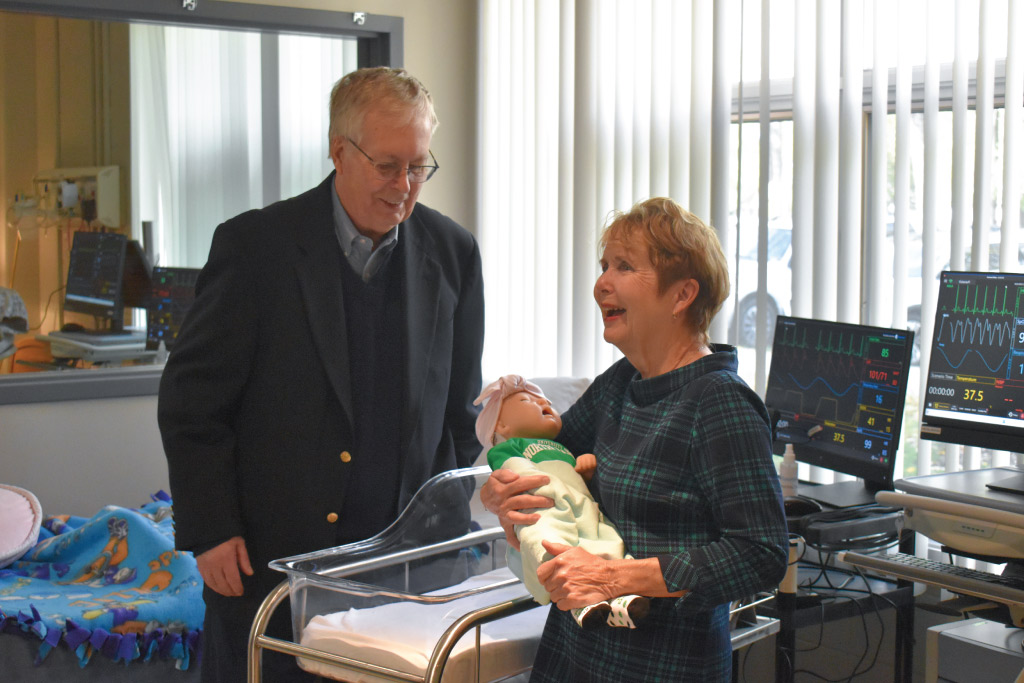New 'Patients' Revolutionize Nursing
Alumna’s gift provides realistic simulators for future nurses.
When Kristine (Aarthun) Solberg, ’69, was taking nursing classes at UND in the mid-to late-’60s, fellow students served as each other’s “patients.”
“We had to pass a nasogastric tube down each other’s noses,” Kris recalled. “We put the flexible, rubberlike tube up through the nose, up through the septum, and down through the back of the throat into the stomach.”

She said it was a most unpleasant experience.
Almost six decades later, the learning landscape has evolved significantly for students at UND’s College of Nursing & Professional Disciplines (CNPD). The Clinical Resource & Simulation Center (CRSC) now offers a state-of-the-art environment with low-, medium-, and high-fidelity manikins that provide simulated learning experiences for nursing, nutrition and dietetics, social work, and graduate-level students. While low-fidelity models remain static, high-fidelity models respond with voices, facial expressions, and moving body parts, simulating scenarios like infant distress, childbirth, or adult emergencies.
Kris – who spent most of her career teaching prenatal and Lamaze classes – and her husband, Bob Solberg, ’69, donated several simulators to the CNPD, and they’re housed in the newly named Kristine Aarthun Solberg Maternal Child Simulation Suite.

Kris Solberg treats the patient, New Victoria, the birthing sim.
New Victoria – The Birthing Sim
According to Nancy Geske-Larson, CNPD simulation manager, “New Victoria,” the birthing sim, allows students to practice various scenarios by snapping on different bellies – a contraction belly, a birthing belly, a belly for practicing Leopold maneuvers (repositioning the fetus), and one simulating a C-section for graduate students.
Students can track contractions, use a fetal monitor to observe the baby, and even experience complications like postpartum hemorrhage, a situation that can get “pretty hairy, pretty fast,” Nancy said. “Students get to be the nurse in charge, feel that stress, and practice critical thinking skills.”
In the lab, faculty can pause the process to explain different interventions, providing a place to learn without impacting patient safety. “Students are more comfortable and prepared when they go to hospitals after seeing a birth here first,” Nancy said.
The birthing sims are among many “patients” in the CRSC. The lab’s highest fidelity sims are designed for students studying to become certified nurse anesthetists. Others provide the opportunity for students to hone their nursing skills.

CNPD students can practice on baby sims like the one pictured here.
The Susies – Adult Sims
Susie 2000 is the main adult simulator used by UND undergraduate nursing students. Her eyes dilate, and she makes lung, heart, and bowel sounds. Students can check her pulse, hook up IVs, insert catheters, and give her blood.
First-semester students learn basic assessments on UND’s mid-fidelity sim, the Susie 1000. In addition to checking heart, lungs, and blood pressure, students practice patient communication.
“When students are new, communicating – actually talking to a patient – can be foreign to them,” Nancy said. “They need to learn to communicate with family members, even kids, in a high-stress hospital environment.”
Conversations occur when Nancy and CRSE Simulation Operations Specialist Paula Reitz provide the patient’s voice from the control room. “We talk into a headset and the voice comes through the manikin.”
Students also practice with Sim Converse, a medical simulation platform that uses AI to play the role of the patient. “The AI generated response is just like talking to a person,” Nancy said. “Listening to it is mind-blowing!”
Other “patients” residing in the CRSC include “Geri,” a geriatric simulator who can sit up and has facial and body features similar to a geriatric patient, as well as pediatric and baby sims.
Hayden Reitmeier, a current UND nursing student, learned about burn victims using sims. “The CRSC team actually singed the sim’s hair so the room smelled like someone was just burned,” he said. “Some classmates and
I had to assess the patient’s burns and calculate fluid needs based on burn percentages, while also addressing their psychosocial needs.”
The burn patient is an example of how sims expose students to unique situations. Hayden said those experiences increase confidence and result in safer patient outcomes.

Bob and Kris Solberg share a laugh as they check out the newly named Kristine Aarthun Solberg Maternal Child Simulation Suite.
Sims Grow Up
Since Nancy started at UND 13 years ago, she said technology has increased tenfold. She’s seen students go from practicing procedures on each other to working on early sims that looked like department store manikins, to today’s sims that track people with their eyes and respond to touch. “Students are using sims in higher-acuity-type scenarios on patients of all ages for almost any issue.”
After touring the lab and the birthing suite that bears her name, Kris was impressed. “This is revolutionizing nursing,” she said. “Students will be better nurses.”



